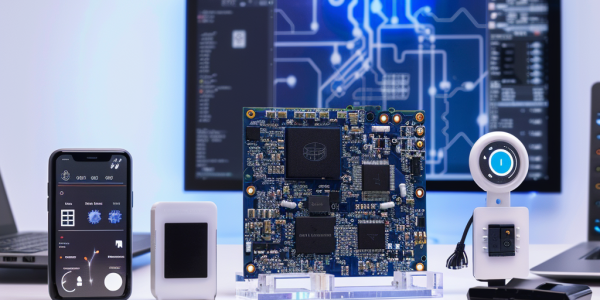Wearable Tech and Machine Learning Transform Fall Risk Prediction in Parkinson’s Patients
A groundbreaking study from the University of Oxford reveals how wearable sensor technology and machine learning can predict fall risk in Parkinson’s disease patients. This innovative approach analyzes walking patterns and postural sway over five years, offering a more objective method for fall risk assessment. With over half of Parkinson’s patients experiencing falls, this research paves the way for personalized interventions, enhancing safety and quality of life for individuals living with this condition.
Alif Semiconductor Launches World’s First AI-Optimized Bluetooth Microcontroller
Alif Semiconductor has launched the Balletto evaluation board, the world’s first Bluetooth Low Energy wireless microcontroller designed for AI and ML workloads. With features like natural language speech recognition and AI noise cancellation, the Balletto MCU is set to revolutionize smart devices, particularly in true wireless stereo earbuds and wearables. This innovation marks a significant step towards more intelligent, compact, and power-efficient technology in the IoT landscape.
Geoffrey Hinton’s AI Predictions: A Decade Later in Radiology
Geoffrey Hinton, the ‘Godfather of AI,’ recently won the Nobel Prize in Physics, drawing attention to his pioneering work in neural networks and its implications for radiology. Despite his past predictions about AI surpassing human radiologists, the current reality shows a significant shortage of radiologists, emphasizing the need for human expertise. AI is emerging as a valuable tool to enhance diagnostic accuracy and efficiency, rather than replace professionals. This evolving landscape calls for a collaborative approach, where radiologists leverage AI to improve patient care.
Harnessing Machine Learning for Enhanced Solar Weather Forecasting in Space Operations
As satellite operators face challenges from solar weather, advancements in machine learning are enhancing space weather forecasting. Researchers are utilizing data from NASA’s Solar Dynamics Observatory to develop predictive models that improve satellite tracking during solar events. This innovative approach is crucial for maintaining operational advantages in increasingly contested space environments.
Aligning AI Models with Human Perception: MIT Research Insights
Recent MIT research reveals that the effectiveness of large language models (LLMs) is heavily influenced by human perceptions and beliefs. The study introduces a novel framework that aligns LLM capabilities with user expectations, highlighting the critical role of human decision-making in AI deployment. Misalignment can lead to overconfidence or distrust in LLMs, impacting their reliability in high-stakes situations. Understanding this relationship between human psychology and AI performance is essential for maximizing the potential of LLMs in various sectors.
Revolutionary AI Technique Unveiled for Material Analysis at Argonne National Laboratory
Researchers at Argonne National Laboratory have developed a groundbreaking AI-NERD technique that combines X-ray photon correlation spectroscopy (XPCS) with artificial intelligence to create unique material fingerprints. This innovative method enhances the understanding of material dynamics and behavior, enabling significant advancements in materials science and various industries, including aerospace and biotechnology.
AI Achieves Spatial Awareness Breakthrough Using Minecraft
Researchers from Caltech have achieved a major breakthrough in artificial intelligence by training a neural network to develop spatial maps using the video game Minecraft. This innovative approach enhances AI’s ability to navigate environments and understand spatial relationships, showcasing a new level of cognitive mapping. Published in Nature Machine Intelligence, the study reveals the neural network’s impressive accuracy in predicting visual frames, marking a significant step towards more intelligent AI systems capable of complex problem-solving.
v4c.ai Emerges as Dataiku Boutique Services Partner, Revolutionizing AI Landscape
v4c.ai has become the next generation of Dataiku Boutique Services Partner, offering strategic services for organizations looking to leverage AI and machine learning. With a focus on enabling organizations to unlock the full potential of their data, v4c.ai’s partnership with Dataiku aims to revolutionize the approach towards AI and machine learning. This collaboration seeks to deliver unmatched data science capabilities and generative AI solutions to clients across various industries.
Researchers Develop Machine Learning Model to Identify Disease Subtypes
Researchers from the Hebrew University of Jerusalem have developed a groundbreaking machine learning model to identify disease subtypes, leading to more precise treatment strategies. The study, published in the Journal of Biomedical Informatics, highlights the importance of distinguishing diseases into distinct subtypes for accurate study and effective treatment. The innovative approach identified 515 disease candidates with previously unannotated subtypes, showcasing the potential of machine learning in expanding our understanding of complex diseases.
Evolution of AI in Intelligence Analysis
Discover the history of artificial intelligence (AI) in analyzing satellite photos, from the early Perceptron model in the 1950s to the latest large language models like GPT-4. Explore how AI has evolved to support human decision-making in intelligence analysis and surveillance, while also raising questions about autonomous capabilities.










